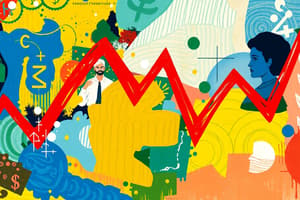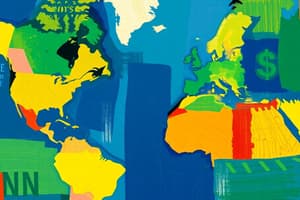Podcast
Questions and Answers
What factors influence the development of exchange rates?
What factors influence the development of exchange rates?
The following factors influence the development of exchange rates: the economic situation of countries, interest rate differences, trade flows, risk premiums.
What is the difference between fixed and flexible exchange rate regimes?
What is the difference between fixed and flexible exchange rate regimes?
- Fixed exchange rates are maintained at a specific value, while flexible exchange rates allow for a currency's value to fluctuate freely against other currencies. (correct)
- Fixed exchange rates allow for a currency's value to fluctuate freely against other currencies, while flexible exchange rates are maintained at a specific value.
- Fixed exchange rates are determined by market forces, while flexible exchange rates are set by the central bank.
- Flexible exchange rates are determined by market forces, while fixed exchange rates are set by the central bank.
According to interest rate parity, how is the return on investment the same at home and abroad?
According to interest rate parity, how is the return on investment the same at home and abroad?
The domestic interest rate roughly corresponds to the difference between the foreign interest rate and the expected devaluation of the foreign currency.
What are the two main components of the balance of payments?
What are the two main components of the balance of payments?
What does a current account surplus imply?
What does a current account surplus imply?
What are the main arguments put forward for or against current account surpluses?
What are the main arguments put forward for or against current account surpluses?
What measures can be taken to reduce a current account surplus?
What measures can be taken to reduce a current account surplus?
What is the ideal currency area according to Mundell?
What is the ideal currency area according to Mundell?
When does a separate currency area make sense according to the OCA theory?
When does a separate currency area make sense according to the OCA theory?
What are some ways that domestic economic policy can impact other countries?
What are some ways that domestic economic policy can impact other countries?
How is an exchange rate expressed?
How is an exchange rate expressed?
A depreciation of a currency results in a decrease in its value.
A depreciation of a currency results in a decrease in its value.
What is the difference between appreciation and depreciation?
What is the difference between appreciation and depreciation?
A current account deficit always indicates a country's economic weakness.
A current account deficit always indicates a country's economic weakness.
The goal of the Theory of Optimum Currency Areas (OCA) is to create a single global currency.
The goal of the Theory of Optimum Currency Areas (OCA) is to create a single global currency.
What is the significance of the Lucas critique in the context of the OCA theory?
What is the significance of the Lucas critique in the context of the OCA theory?
Which of the following scenarios is NOT an example of how domestic economic policy can impact other countries?
Which of the following scenarios is NOT an example of how domestic economic policy can impact other countries?
What happens when a country specializes according to the principle of comparative advantage?
What happens when a country specializes according to the principle of comparative advantage?
Intra-industry trade is a key component of the Heckscher-Ohlin model.
Intra-industry trade is a key component of the Heckscher-Ohlin model.
What is a potential reason for external economies of scale?
What is a potential reason for external economies of scale?
What are some of the potential disadvantages of a current account deficit?
What are some of the potential disadvantages of a current account deficit?
Flashcards
Currency Appreciation
Currency Appreciation
Increase in the value of a currency relative to others.
Currency Depreciation
Currency Depreciation
Decrease in the value of a currency relative to others.
Surplus
Surplus
When a country exports more than it imports.
Deficit
Deficit
Signup and view all the flashcards
Competitiveness
Competitiveness
Signup and view all the flashcards
Capital Inflow
Capital Inflow
Signup and view all the flashcards
Developing Countries
Developing Countries
Signup and view all the flashcards
Investment Returns
Investment Returns
Signup and view all the flashcards
Monetary Policy
Monetary Policy
Signup and view all the flashcards
Exchange Rate
Exchange Rate
Signup and view all the flashcards
Euro to Dollar Conversion
Euro to Dollar Conversion
Signup and view all the flashcards
External Trade
External Trade
Signup and view all the flashcards
Economy
Economy
Signup and view all the flashcards
US Economy
US Economy
Signup and view all the flashcards
Dollar Value Increase
Dollar Value Increase
Signup and view all the flashcards
Trade Balance
Trade Balance
Signup and view all the flashcards
Economic Growth
Economic Growth
Signup and view all the flashcards
Global Investments
Global Investments
Signup and view all the flashcards
Paid Exports
Paid Exports
Signup and view all the flashcards
Inflation
Inflation
Signup and view all the flashcards
Balance of Payments
Balance of Payments
Signup and view all the flashcards
Trade Deficit Impact
Trade Deficit Impact
Signup and view all the flashcards
Market Demand
Market Demand
Signup and view all the flashcards
Foreign Currency
Foreign Currency
Signup and view all the flashcards
Investment Risks
Investment Risks
Signup and view all the flashcards
Gross Domestic Product (GDP)
Gross Domestic Product (GDP)
Signup and view all the flashcards
Currency Exchange Market
Currency Exchange Market
Signup and view all the flashcards
Trade Policies
Trade Policies
Signup and view all the flashcards
Interest Rate
Interest Rate
Signup and view all the flashcards
Economic Indicators
Economic Indicators
Signup and view all the flashcards
Study Notes
International Economics - Monetary Economics
- Exchange Rates and Foreign Exchange Markets: Exchange rates are determined by market equilibrium, where demand equals supply. Demand and supply are influenced by economic factors like exports, imports, and investment flows.
- Balance of Payments: The balance of payments tracks all economic transactions between a country and other countries. It has two main components: the current account (including goods and services trade, investment income, and current transfers) and the capital account (including financial investment and capital transfers). A surplus in the current account indicates more income from foreign transactions than spending on foreigners.
- Exchange Rate Determination: Different theories explain how exchange rates are determined, including factors like interest rate differentials and macroeconomic conditions.
- Optimum Currency Areas and the Euro: The theory of optimum currency areas (OCA) examines the ideal circumstances for a single currency. Criteria like factor mobility, economic similarity, and trade flows matter for deciding whether a group of countries should share a common currency. The eurozone, in particular, operates under such a system.
- Economic Policy in an Open Economy: Economic policies within one country affect other countries, particularly in an open economy. Influences including trade flows, capital flows, exchange rates and fiscal policies must be considered in the open economy.
- What are Exchange Rates? Exchange rates can be expressed as the price of one currency in terms of another (price notation) or as the quantity of one currency that can be bought with one unit of another currency (quantity notation).
- Changes in Exchange Rates: Changes in exchange rates can be devaluations (domestic currency loses value) or appreciations (domestic currency gains value). These changes can be related to factors affecting domestic demand and supply of currencies in the market.
- Driving Forces of Exchange Rates: Macroeconomic factors like economic growth, interest rates (differences between interest rates in countries), trade flows, and perceived risk play a critical role in determining exchange rates.
- Exchange Rate Regimes: Exchange rate regimes determine how the value of a currency is set. Fixed exchange rates involve central bank intervention to maintain a specific rate, whereas flexible exchange rates rely on market forces.
- Foreign Exchange Markets with Flexible Exchange Rates: A flexible exchange rate system allows the value of a currency to adjust based on market forces of demand and supply. Transactions like exports and imports cause currency demand and supply fluctuations. Currency appreciation or depreciation are possible outcomes of these changes.
- Foreign Exchange Markets with Fixed Exchange Rates: In a fixed exchange rate system, central banks intervene to maintain the desired exchange rate. They adjust the money supply to match and counter the upward or downward pressure on the rate. Countries following this regime are not independent in their monetary policy decision.
- Choice Between Domestic and Imported Goods: The choice influences country's trade balance and competitiveness. Consumers make their decisions based on relative prices of goods in the domestic market vs. foreign markets. Interest rate differences, and exchange rate expectations are relevant to domestic vs foreign investment.
- Choice Between Domestic and Foreign Investments: The choice involves considering interest rate differentials and expectations about future exchange rates.
- Interest Rate Parity: This principle suggests that returns on investment should be similar in different countries, leading to a relationship between interest rates and expected exchange rate changes.
- International Transactions in the Statistics: The balance of payments tracks a country's international transactions, including the current account (trade in goods and services, incomes, current transfers) and capital account (financial flows). A country's current account surplus/deficit reflects its net lending to, or borrowing from, other countries.
- Current Account: Summarizes the flow of goods, services, income, and current transfers into and out of a country.
- Current Account as an Indicator for Competitiveness: Current account surpluses or deficits may not fully demonstrate national competitiveness (production or export capability) because numerous factors can affect the account.
- Theory of Optimum Currency Areas (OCA): The OCA theory suggests that certain criteria - factor mobility and economic similarity - influence whether countries benefit from using a common currency. Countries with asymmetric shock responses may benefit from independent currencies
- Economic Policy in an Open Economy: Monetary and fiscal policies in one country can impact other countries through trade flows, capital flows, exchange rates, and related mechanisms.
- Additional Exercises: These exercises provide examples of problems related to the concepts discussed above, including practical scenarios related to exchange rates, trade balances, and economic policies.
Studying That Suits You
Use AI to generate personalized quizzes and flashcards to suit your learning preferences.




